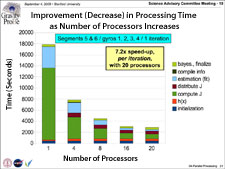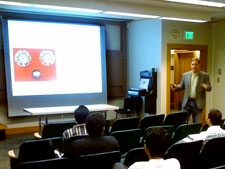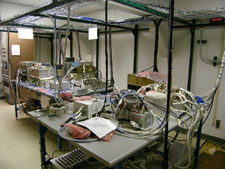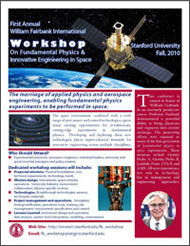Chapter 6A
THIRD CHALLENGE: SPACE BIOLOGY
The well-being of human life has been the ultimate justification for the physical branches of space science. But can we justify the space science of life itself? What is the value of doing biology in space? Many observers, space scientists included, do not think highly of the scientific prospects of the field. The main purpose of this and the next few postings is to meet their objections, to show that the study of life in space also shows the serendipitous, deep practicality of the other space sciences.
Space biology can be roughly divided into two main areas. The first investigates the possibility of extraterrestrial life; it goes by the name of exobiology, or, more recently, astrobiology. The second investigates the behavior of terrestrial life in outer space; it corresponds to the idea most laymen have of space biology[1]. Since these two areas are distinct, they require separate analysis and separate justification.
Exobiology/Astrobiology
Introduction.
It used to be said with derision that exobiology is a science without subject matter. We have never found any alien life, and for all we know terrestrial life might be the only life in the universe. Or even if there is life somewhere else we might never find it. Or if we stumble upon it by chance, we might not recognize it as life.
Exobiology did have its moment of fame in 1975 with the Viking missions to Mars; but, after the Viking landers failed to find life, the field steadily declined in prestige and seemed moribund until two extraordinary developments resuscitated it.
The first was the dramatic advance in the search for planets around other stars. In the last few years hundreds of extraterrestrial planets have been discovered, most of them gas giants even larger than Jupiter, but we are also beginning to find rocky planets a bit larger than the Earth. This development was extraordinary because even the best telescopes were not expected to take pictures of planets many light years away from us. Some researchers had claimed to detect the presence of large planets by the wobble they caused on the paths of their parent stars, but it was generally agreed that such “wobble” was comfortably within the margin of error of the observations. Researchers hoped that a generation of space telescopes yet to come might help, until some clever astronomers invented a completely novel approach: the tug and pull of a planet on a star, if they are both on our line of sight, will make the star move away or toward us. That means that the star’s light would be shifted towards the red, if the star is moving away from us, or towards the blue if it is moving towards us. Spectral analysis, thus, has made the discovery of new planets routine. The planets found so far are very close to their stars, even closer than Mercury is to the Sun, but that is not to say that all extraterrestrial planets are that close. It should be expected that the first planets we found by measuring how much their gravitational pull disturbs their stars’ orbits should be precisely those that are very close to their stars. All these discoveries have been supplemented by the observations, with infrared telescopes mostly, of planetary systems in formation – observations that make plausible the existence of terrestrial planets throughout the galaxy.
The second extraordinary development was the discovery of organic compounds in a Martian meteorite (ALH84001), and the tantalizing suggestion that some worm-shaped structures found inside might be fossils of extremely small Martian bacteria. The monumental excitement created by the announcement led to a very ill-tempered controversy between groups of scientists that I will discuss later in this section. Both sides would agree, however, that the discovery of extraterrestrial life would give us good reason to get excited. For by comparing terrestrial and extraterrestrial life we would learn much about our own life and our own planet.
We can readily see that the possibility of such a comparison may provide an excellent motivation for the pursuit of exobiology, and so this will be the first issue I will discuss. I will then examine the negative results of the search so far and evaluate the hope created by the Martian meteorite. And, finally, I will determine why it makes sense to continue doing astrobiology even in the face of uncertain results.
1. The Motivation for Astrobiology
What would extraterrestrial life enable us to learn about our own kind of life? The answer is clear. All life on this planet is based on the same carbon chemistry and apparently all have the same genetic code. Of the many possible amino acids, only twenty are used to build proteins. DNA, the reproductive code for terrestrial life, makes use of only four bases. Moreover, organic molecules can be left handed or right handed, but terrestrial life prefers left-handed amino acids and right-handed sugars. Are these circumstances mere accidents of organic evolution, or are there fundamental reasons why life has taken these particular turns on this planet? Even one other kind of life would permit us to make great strides in examining these matters. For that other life may use a wider range of amino acids and bases, or it may prefer right-handed amino acids or left-handed sugars. One result of such a finding may be that, say, a particular chemical balance in the Earth’s oceans caused the preference for left-handed amino acids. Or the alien life may be similar to life on Earth, which would reveal to us some sort of organic inevitability. In either case, if we have knowledge of the natural environments of that alien life, we can begin to understand why certain paths open to organic evolution are conducive to replication. The new perspective would be very fruitful in trying to understand our own biology at all levels.
It would be especially useful to observe stages of organic evolution and to study life as it begins in a new world, or at least to find fossil records of such beginnings. Beyond the stage of primitive cells, radically different alien forms of life would still offer great rewards, as we will see below. Even if perchance organic evolution produced in two similar planets similar primitive cells with essentially the same genetic code, the subsequent evolution would have much to teach us, for life in those two planets would undergo different histories of adaptation. Imagine, for example, that the now famous Alvarez asteroid had not crashed on the Earth. No one knows how dinosaurs would have continued to evolve, but it is possible that their grip on the surface of the planet would have been further strengthened. Mammals might have been thus forever condemned to crawl and scratch in the night like so many other vermin.
Even similar planets are likely to exhibit different tectonic histories. Plate tectonics brings continents together or breaks them apart; it throws chains of mountains up over the landscape; and it creates volcanoes where the plates rub against each other. In doing so it brings some habitats to an end and others into existence; it destroys; it influences; it changes life in many ways. Consider how the variation in the size of landmasses influences the fauna and flora of a planet. Certain large animals, for example, need a large environment in which they can roam for long distances. Elephants used to travel many hundreds of miles in their annual migrations. As these big mammals went along, they ate a variety of plants, thus insuring a balanced diet and permitting the vegetation at every feeding stop enough time to recuperate. Their considerable droppings were recycled, in the meantime, by armies of insects and bacteria. In a much smaller environment the vegetation would have been devastated, and the elephants would have suffered from poor diets and the unsanitary rot of their own excrement.[2] They would not have been fit.
Slight differences at the beginning of the history of a planet would alter the make-up of the crossroads that life has to face, first at the level of organic chemistry, and then at the level of cells — presuming that cells are common to living things. A eukaryotic cell (a cell with a nucleus) may well be the result of symbiosis between different varieties of prokaryotic cells (without a nucleus).[3] For example, the mitochondria in eukaryotic cells (see Figure 1) may be the remnants of prokaryotic cells that discovered how to use oxygen for energy and were swallowed but not digested by larger bacteria. Since eukaryotic cells are the building blocks of all complex organisms on Earth, we can imagine that different symbiotic relationships between primitive cells might have led to forms of life vastly different from those of our acquaintance. On planets so endowed, the subsequent interaction of life with the rest of the environment would have a multiplier effect, for they would change their environment in novel ways, and those new environments would lead life to adaptations that on Earth could meet only with misfortune.
Acquaintance with such alternative biotas would inevitably lead to profound transformations in biology, since biology would grow, and scientific knowledge seldom grows without changes. In this, scientific knowledge resembles animals. Mammals, for example, did not just get bigger after the extinction of the dinosaurs. As their size increased, the structure of their skeletons had to change to accommodate their larger weight. In a planet with gravity similar to ours, a dog the size of an elephant would probably look much like an elephant. In an analogous manner, a science of biology that were suddenly much larger in subject matter would have to grow connections and supporting structures for which there was little need in the days of a single biota.
[1]. I do not divide the field in the manner that NASA has found convenient for a variety of administrative reasons (according to which, for example, Space Biology is only a small section of the Life Sciences Division). My division follows rather the convenience of the argument and of the reader.
[2]. Adapted from R.M. Laws, I.S.C. Parker, and R.C.B. Johnstone, Elephants and their Habitats, Clarendon Press, Oxford (1975).
[3]. For an informal, though detailed account of these issues see Gene Bylinsky, Life in Darwin's Universe, Doubleday, 1981.










